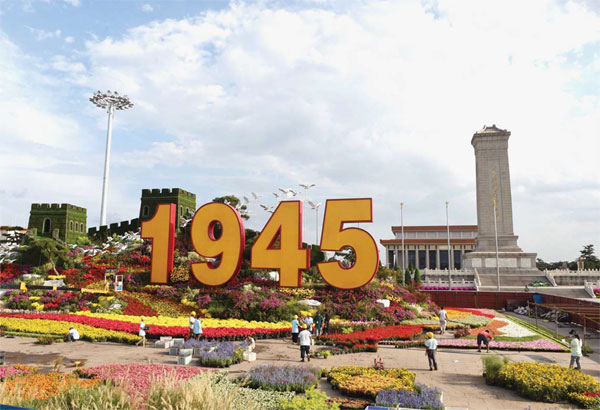Blue skies over Beijing ... for now
Updated: 2015-09-05 07:44
By Wang Mingjie(China Daily Europe)
|
|||||||||||
Measures may keep smog at bay for a while, but experts want long-term strategy
|
Workers decorate Beijing streets to welcome the military parade on Sept 3. Luo Xiaoguang / Xinhua |
Seeing a blue sky in Beijing has been regarded as luxury in recent years because of air pollution, but in the past few months the smog has largely disappeared from the Chinese capital.
The good weather has been dubbed "parade blue" as a result of the suspension of factories and construction sites in neighboring areas, as well as vehicle restrictions in the capital, in an effort to ensure clear skies for the big military parade that took place on Sept 3.
The parade, which took place on Sept 3, was the first staged by China to commemorate the end of World War II, this year being the 70th anniversary of V Day.
The authorities similarly closed factories in November before a meeting in the city of Asia-Pacific leaders, resulting in a period of weather dubbed "APEC blue".
Data from the city's environmental protection bureau show the average level of PM2.5 - harmful fine particulate matter - was 19.5 micrograms per cubic meter between Aug 21 and Aug 25.
Long-term exposure to PM2.5, airborne particles smaller than 2.5 micrometers that can penetrate the lungs, can result in cancer, heart disease, strokes and lung disease, according to the World Health Organization.
"Temporary measures can be effective at reducing pollution but are blunt instruments that can produce very high economic costs," says Fergus Green, a policy analyst for the Grantham Research Institute on Climate Change and the Environment at the London School of Economics and Political Science.
"They are no substitute for a comprehensive strategy and set of policies for reducing pollution and greenhouse gas emissions in the transport sector."
In Beijing, as in other cities, vehicles are the biggest source of pollution, contributing almost a quarter of the total PM2.5 emissions, followed by coal burning.
In the three months to June, the capital topped a list of 45 major Chinese cities for traffic congestion, with the frequent use of ride-hailing services a major factor, according to AutoNavi Software Co, a mobile Web mapping and navigation service.
Effectively tackling pollution while maintaining sustainable economic growth has become a headache for the Beijing municipal government.
Today's Top News
Acquiring knowledge, building strength
Foreign bears don't affect China - yet
Austria to end messures letting migrants in
Ex-VP nominee Palin: Immigrants in US should 'speak American'
China 2014 GDP growth revised down to 7.3%
White paper on Tibet reaffirms living Buddha policy
Austria, Germany open borders to migrants
PBOC governor says stock market correction roughly in place
Hot Topics
Lunar probe , China growth forecasts, Emission rules get tougher, China seen through 'colored lens', International board,
Editor's Picks

|

|

|

|

|

|







